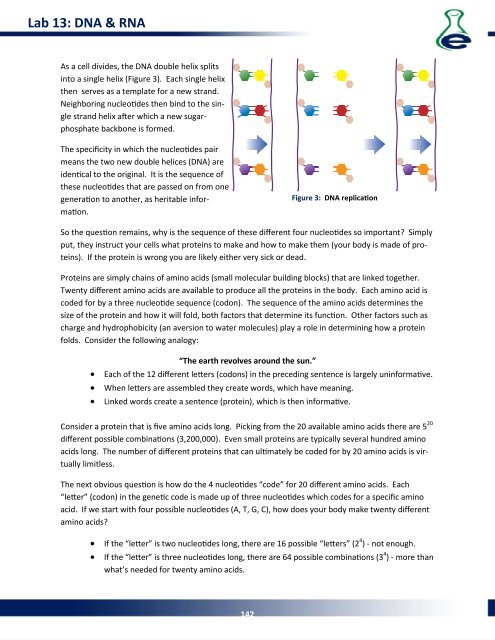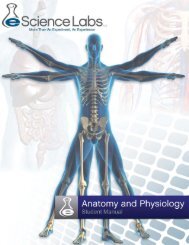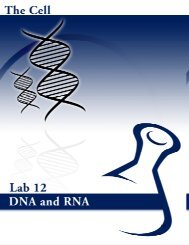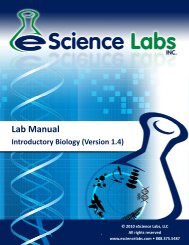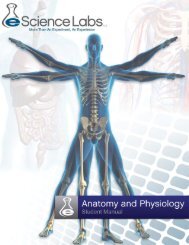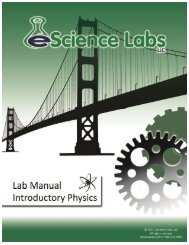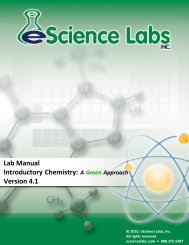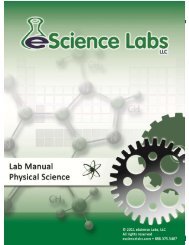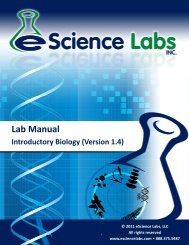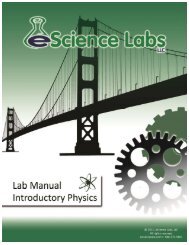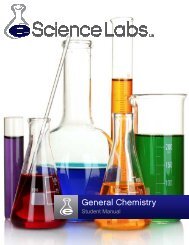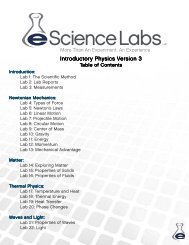Lab Manual - eScience Labs
Lab Manual - eScience Labs
Lab Manual - eScience Labs
Create successful ePaper yourself
Turn your PDF publications into a flip-book with our unique Google optimized e-Paper software.
<strong>Lab</strong> 13: DNA & RNA<br />
As a cell divides, the DNA double helix splits<br />
into a single helix (Figure 3). Each single helix<br />
then serves as a template for a new strand.<br />
Neighboring nucleodes then bind to the single<br />
strand helix aer which a new sugarphosphate<br />
backbone is formed.<br />
The specificity in which the nucleodes pair<br />
means the two new double helices (DNA) are<br />
idencal to the original. It is the sequence of<br />
these nucleodes that are passed on from one<br />
generaon to another, as heritable informaon.<br />
Figure 3: DNA replicaon<br />
So the queson remains, why is the sequence of these different four nucleodes so important? Simply<br />
put, they instruct your cells what proteins to make and how to make them (your body is made of proteins).<br />
If the protein is wrong you are likely either very sick or dead.<br />
Proteins are simply chains of amino acids (small molecular building blocks) that are linked together.<br />
Twenty different amino acids are available to produce all the proteins in the body. Each amino acid is<br />
coded for by a three nucleode sequence (codon). The sequence of the amino acids determines the<br />
size of the protein and how it will fold, both factors that determine its funcon. Other factors such as<br />
charge and hydrophobicity (an aversion to water molecules) play a role in determining how a protein<br />
folds. Consider the following analogy:<br />
“The earth revolves around the sun.”<br />
• Each of the 12 different leers (codons) in the preceding sentence is largely uninformave.<br />
• When leers are assembled they create words, which have meaning.<br />
• Linked words create a sentence (protein), which is then informave.<br />
Consider a protein that is five amino acids long. Picking from the 20 available amino acids there are 5 20<br />
different possible combinaons (3,200,000). Even small proteins are typically several hundred amino<br />
acids long. The number of different proteins that can ulmately be coded for by 20 amino acids is virtually<br />
limitless.<br />
The next obvious queson is how do the 4 nucleodes “code” for 20 different amino acids. Each<br />
“leer” (codon) in the genec code is made up of three nucleodes which codes for a specific amino<br />
acid. If we start with four possible nucleodes (A, T, G, C), how does your body make twenty different<br />
amino acids?<br />
• If the “leer” is two nucleodes long, there are 16 possible “leers” (2 4 ) - not enough.<br />
• If the “leer” is three nucleodes long, there are 64 possible combinaons (3 4 ) - more than<br />
what’s needed for twenty amino acids.<br />
142


